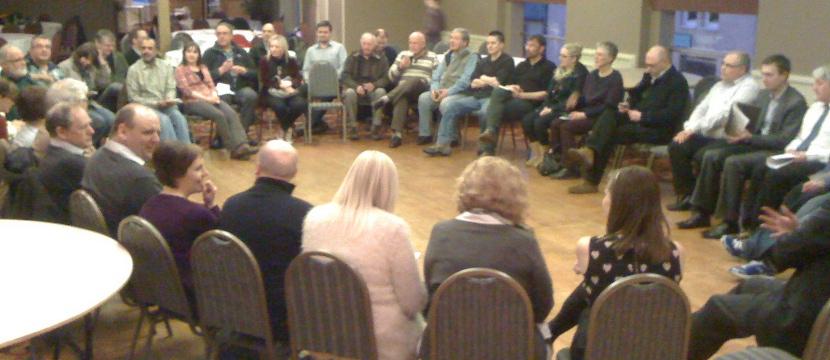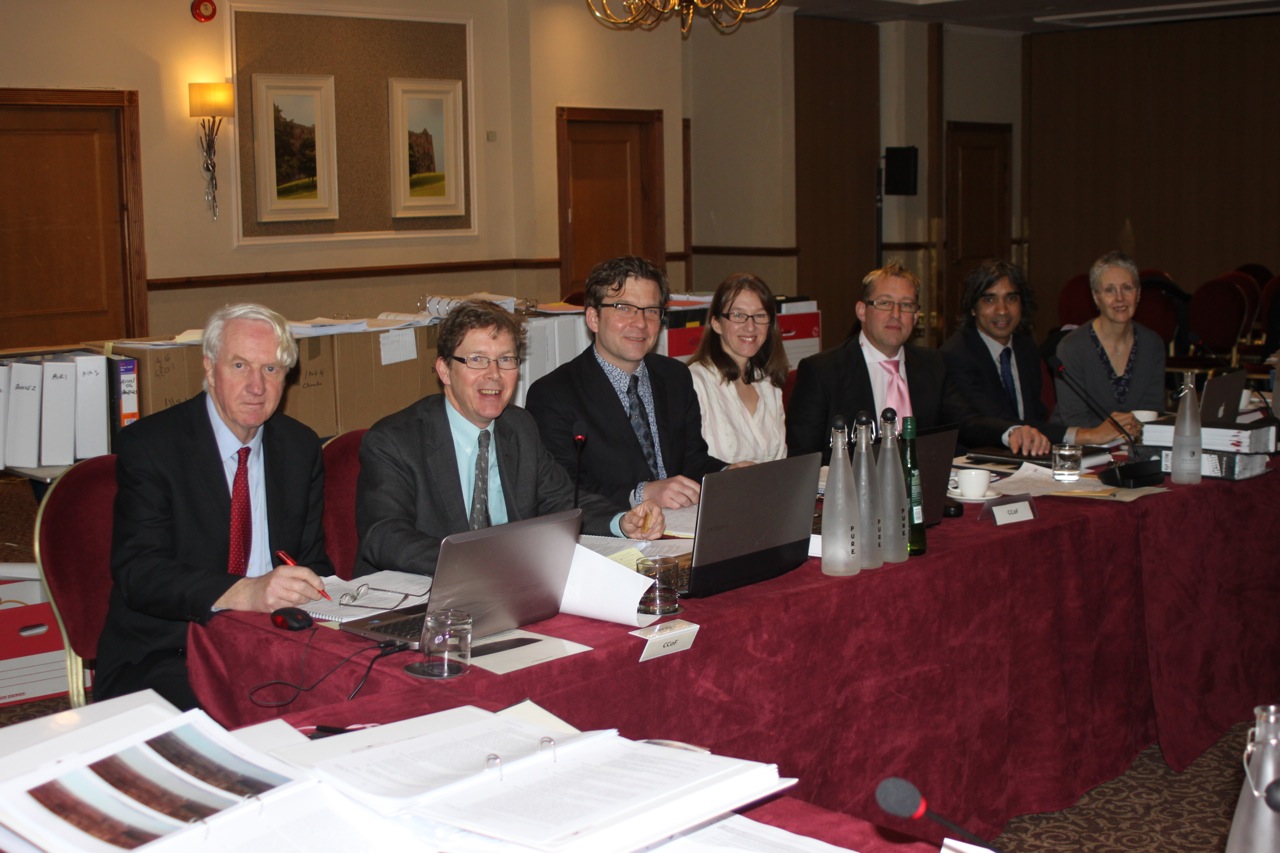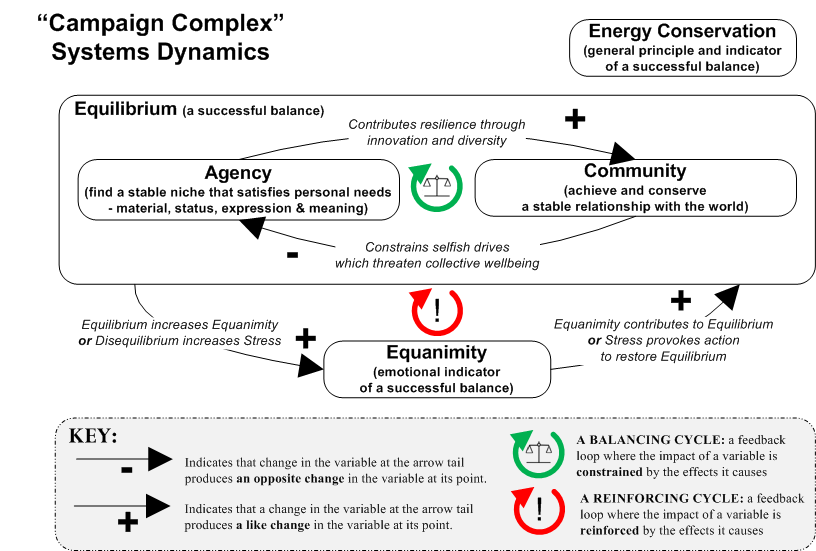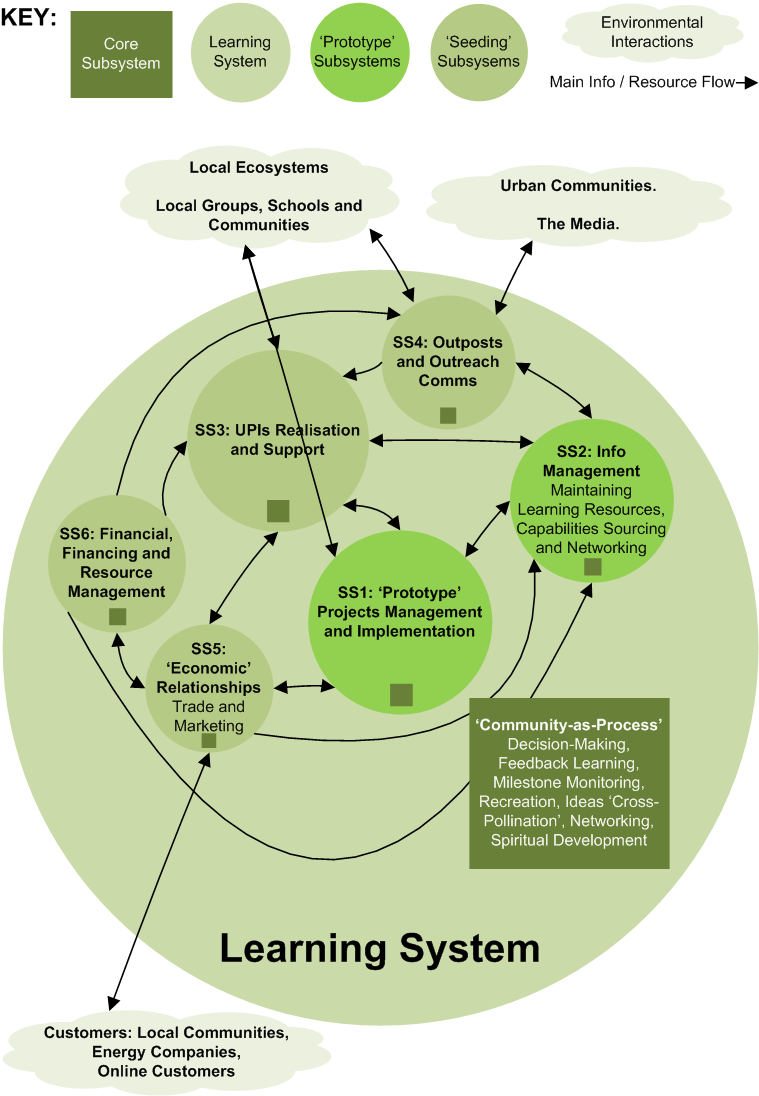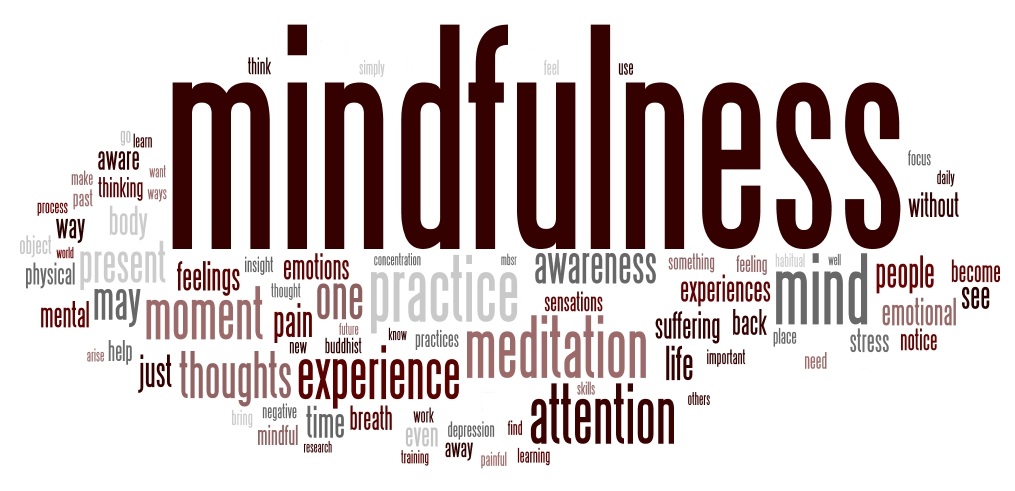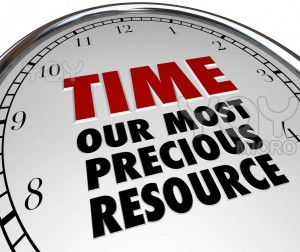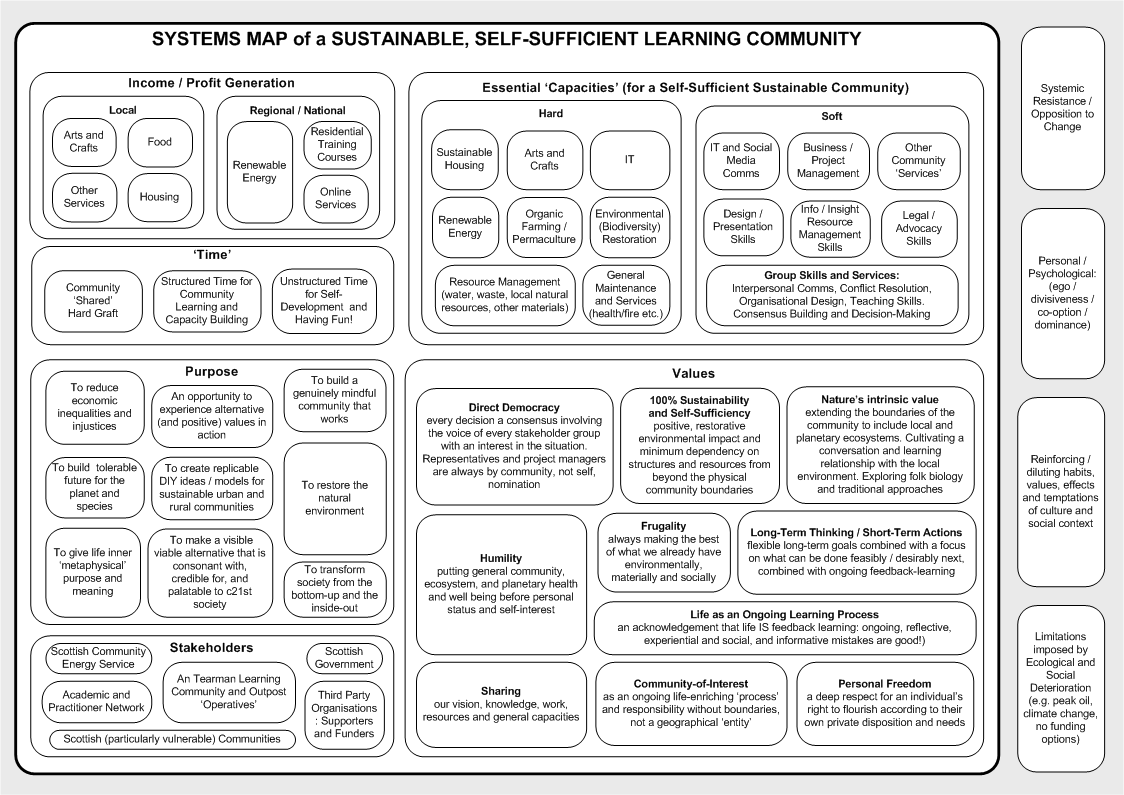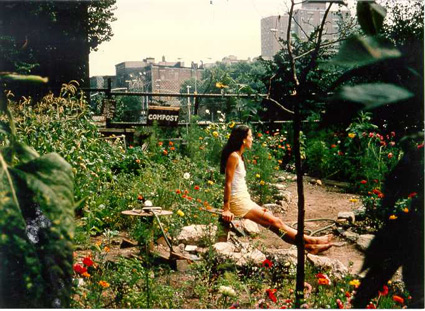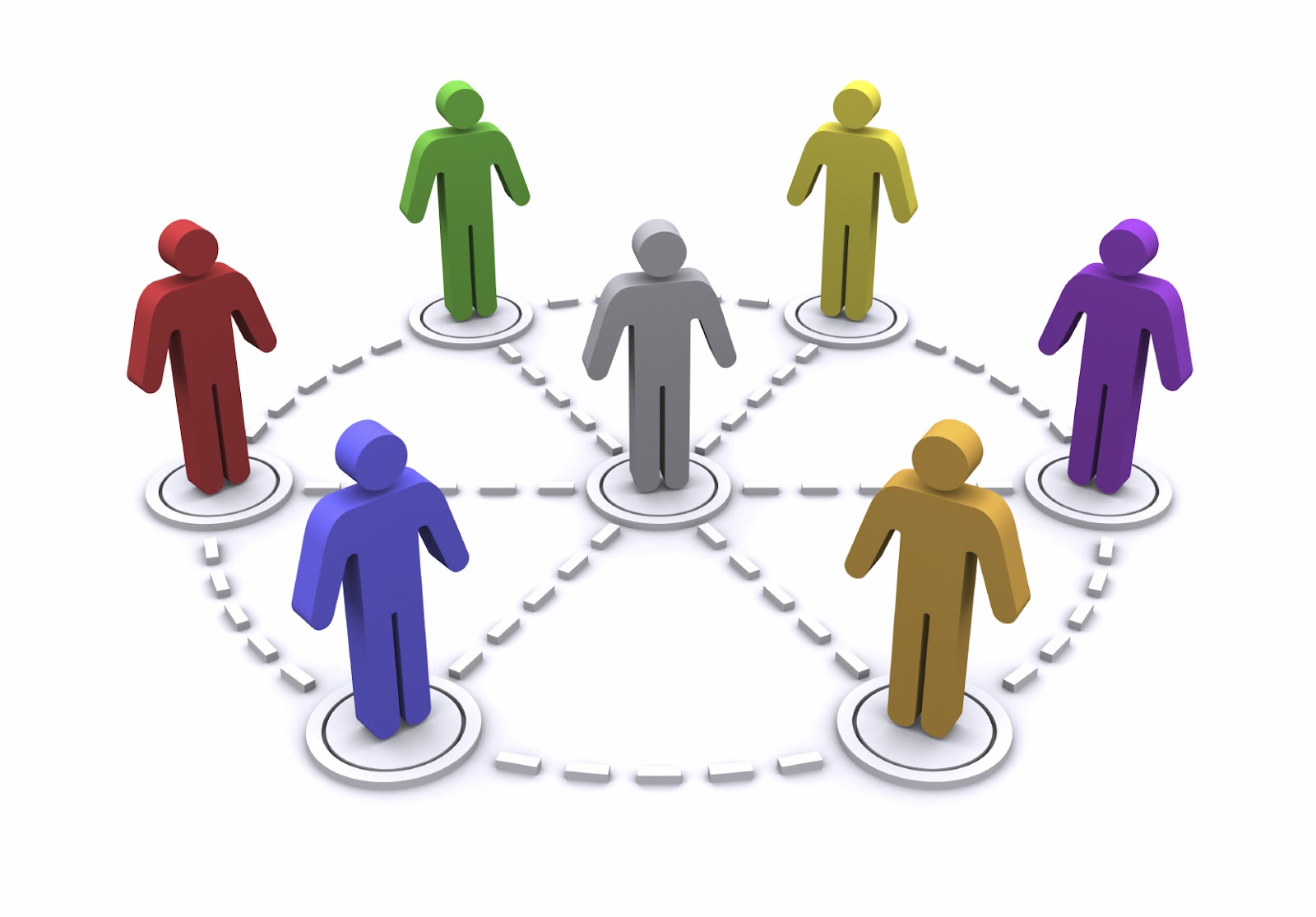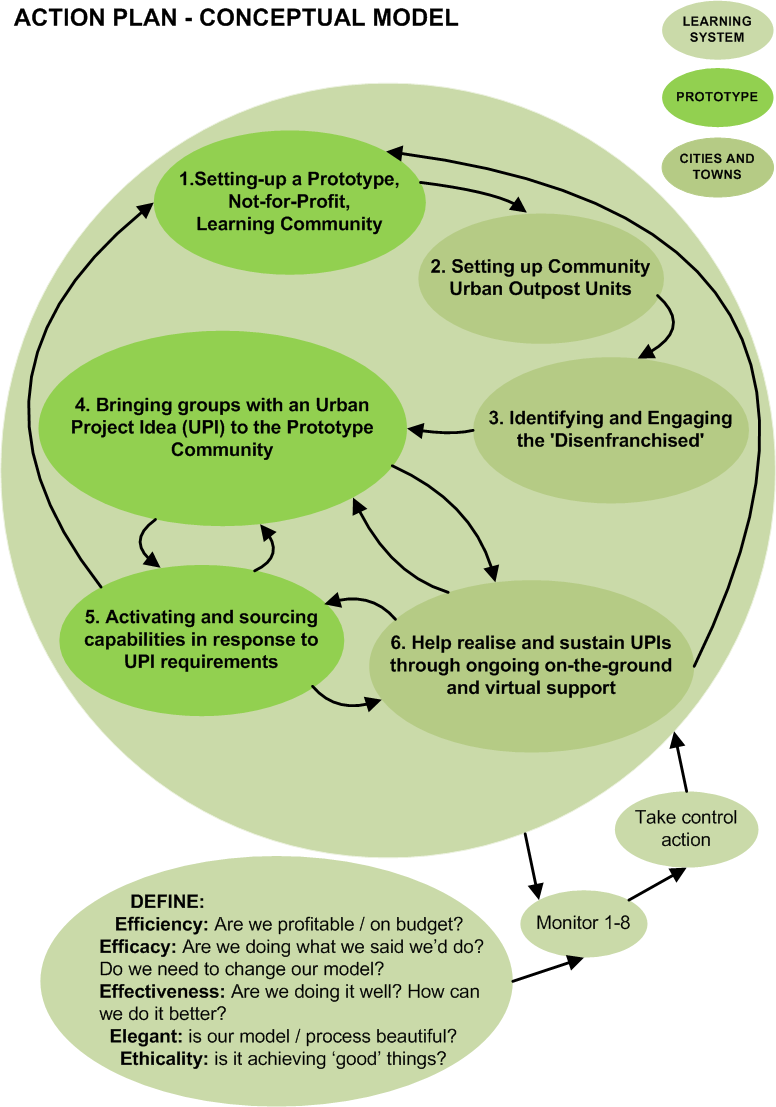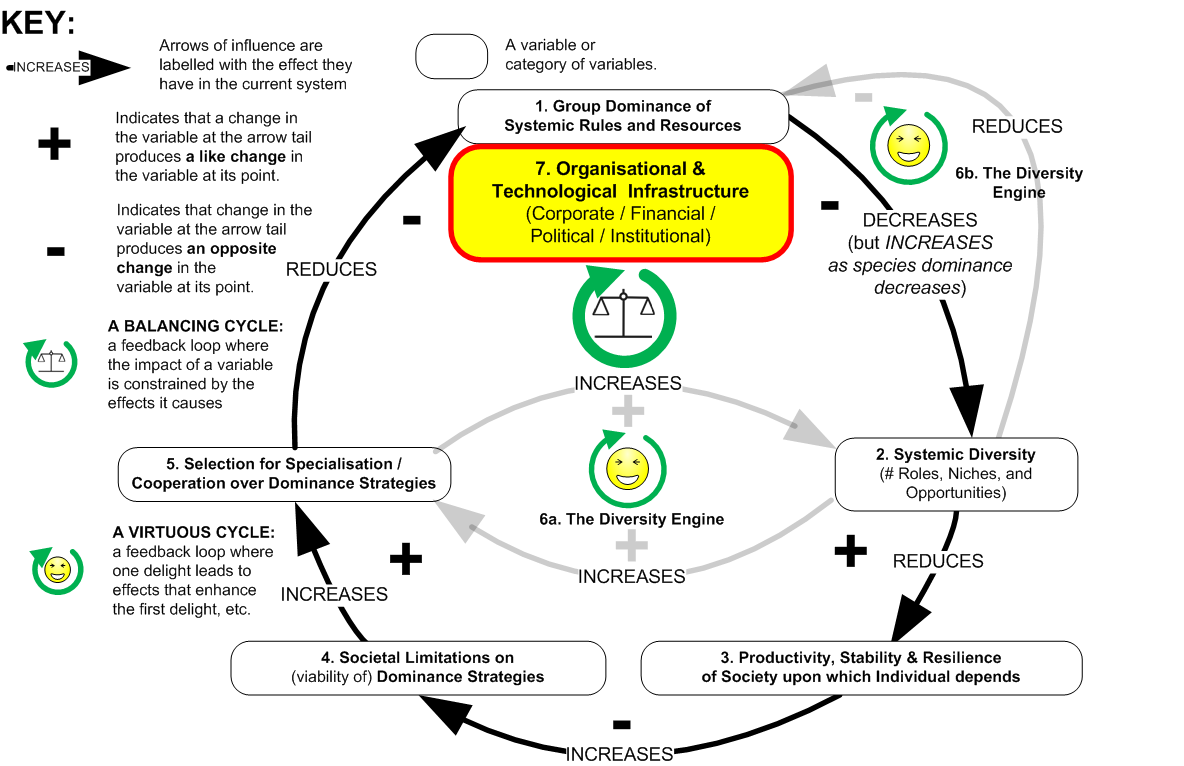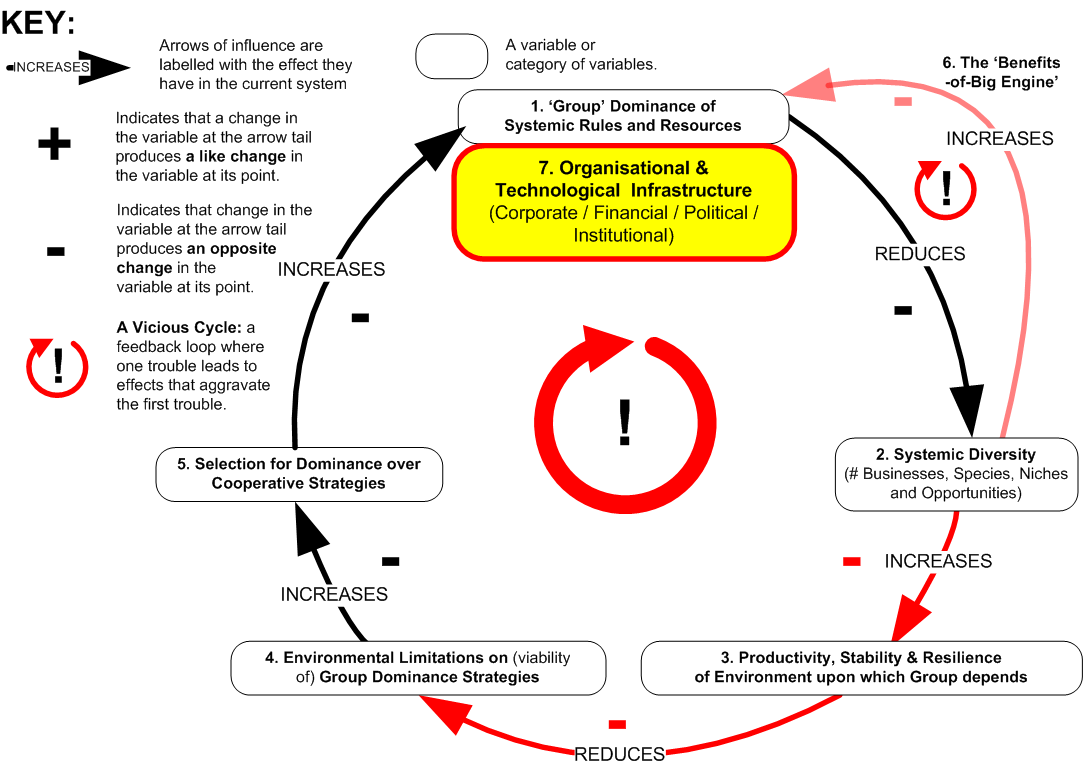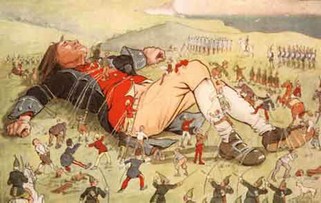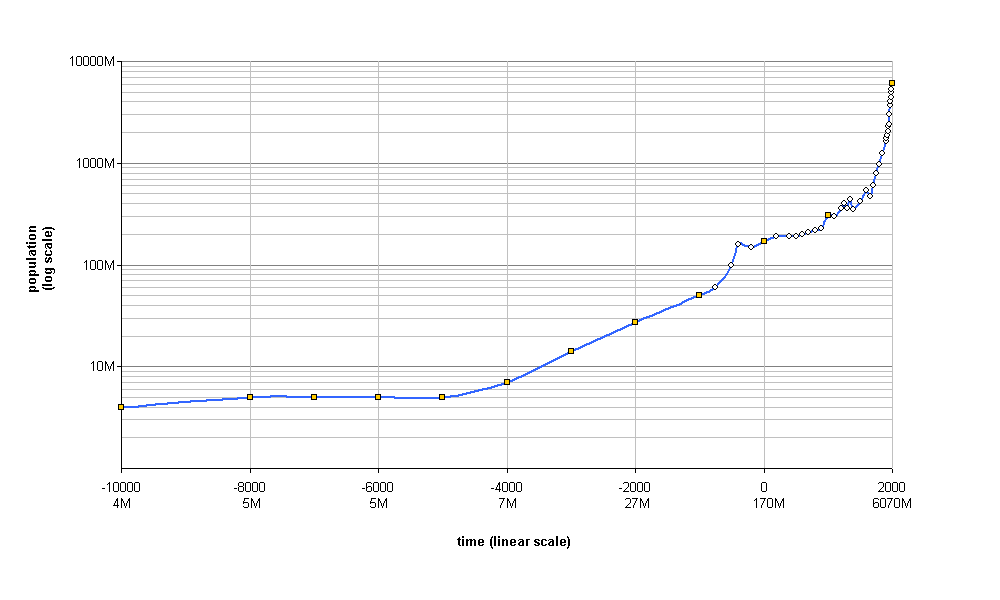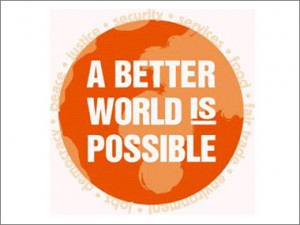Positive Change using Biological Principles, Pt 4: Principles in Action
Welcome to the final part in our series about social change strategy.
In part 1, we proposed a “Campaign Complex” comprised of four “biological” Principles – Equilibrium, Agency, Equanimity and Energy Conservation – which might account for some common challenges experienced by change agents. We outlined some strategies for successful campaigning suggested by these Principles.
In part 2, we proposed and discussed a “missing” fifth “Community Principle” implied by the other four, and suggested that some technologies – particularly transport and communications – may have facilitated its disintegration, by enabling “Agency” to bypass the constraints of geographical community.
In part 3, we discussed the benefits and costs associated with freedom from the “Community Principle”. We postulated that, ultimately, cultural and personal costs outweigh the benefits, and that resulting vicious circles may underpin and reinforce common campaigning bugbears.
In this final part, we will outline a Case Study which illustrates some of the positive characteristics of the Campaign Complex, particularly the Community Principle. We also propose the control parameters responsible for the re-emergence of the Principle in this context, and the implications it could have for change-oriented organisations.
Reactivating the Community Principle
In recent years, communities around the world have begun to exhibit a profound collective response to environmental crisis and encroachment by harmful industrial development.
This has frequently been sparked by onshore unconventional gas development (“fracking”, coalbed methane or coal seam gas, and underground coal gasification). Notable exemplars include the Community Bill of Rights Movement in the USA, and the “Lock the Gate” Alliance in the Northern Rivers region of New South Wales, Australia.
One such case, of which Arkadian has first hand experience, is the Falkirk Against Unconventional Gas campaign. This began in September 2012, when residents of a Scottish community received notification of a proposal by Dart Energy to extract coal bed methane near their homes – the UK’s first application to commercialise the Dash-for-Gas.
Fragmented information-sharing initiatives by community councils and local residents soon coalesced into a series of general public meetings. Here, individual concerns about impacts on health and property values evolved into a general concerns about a common threat to community Equilibrium and Equanimity.
Meetings were supported by structured group decision-making and independent third-party facilitation. These processes complemented the Agency Principle by enabling a diverse group of residents to pool individual expertise and share equal ownership of outcomes.
The collective response emerged in the form of two groundbreaking documents.
The first was a pro-forma objection letter – the Community Mandate – which began with the community’s visions of 20yrs in the future – one born from local council policy and residents’ aspirations, and the second, what the area might look like if the industry rolled out. It also set out residents’ evidence for suspected risk and their own minimum requirements for its assessment and regulation.
3 months later, over 2500 had been signed and submitted, including representation by over 80% of some affected villages.
A group of residents, each with modest door-knocking goals (satisfying the Energy Conservation Principle) in a short time achieved the biggest response to a planning application in the history of the local authority.
The second document – the UK’s first Community Charter – wholly redefined the narrative from “fighting against” to “fighting for”. Drawing from the Mandate’s positive vision, the Charter set out those shared assets, values and aspirations – termed “Cultural Heritage” – which were agreed by consensus to be fundamental to local health and well-being.
Assets, agreed unanimously, included the goal of a clean and safe environment, the healthy development of children, the sanctuary of the home, the diversity and stability of the local ecosystem, the resilience and continuity of the community. and trust in elected representatives.
The Charter also set out the community’s basic right and responsibility to safeguard and improve their “Cultural Heritage”, in order that they could pass it onto future generations in a better state than they inherited it.
This provided a remarkably detailed and concrete definition of that notoriously slippery term: “sustainable development”. It also illustrates that it’s only really meaningful if delineated and maintained by general consent at a local level.
This broadening of “Cultural Heritage” to encompass the fabric of interrelationships that creates community, including both tangible and intangible assets, also finds support in the Council of Europe Framework Convention.
The Charter has since been adopted by 3 local Community Councils, half of all Local Authority Councilors and an ever-growing number of local farmers and residents. It was also recognised by Scottish Government as requiring a special session in the recent public inquiry to decide the application, the UK’s first in relation to the Dash-for-Gas. Here, and in later Hearing sessions (see below), local residents, farmers and councilors gave evidences about the impact of the development on their aspirations and experience.
Regardless of the outcomes of this public inquiry, nothing seems more likely to succeed, ultimately, than a community thinking and acting together to protect the shared fundaments of its Equilibrium and Equanimity.
And the Control Parameters?
1) A COMMON THREAT (AND PURPOSE) PERCEIVED;
2) A vision of what true Equilibrium and Equanimity look like (set out in the Community Mandate and Charter);
3) A few souls brave enough to cold-call an unknown neighbour;
4) Simple processes which supported collective assessment and decision-making (Agency Principle); and
5) Modest collective goals and successes at the outset (Community and Energy Conservation Principles).
That’s all!
It didn’t take much for people to feel re-empowered by the wisdom and the scale of what could be achieved together, and why this was important. Negotiating a diversity of perspectives has involved conflict and compromise (neither much appreciated by “Agency”), but the compensations have been more than worth the pain – collective vision and support, social learning, and novel opportunities for individual expression, powerful friendships, and fun.
Moreover, though Part 2 suggested some technologies facilitated the disintegration of Community, the same technologies here have played an invaluable role in maintaining strategic communications among residents, and with other community groups and experts across the globe. The technology itself is neutral and while it may offer “Agency” easy routes to self-satisfaction, in the service of collective purpose it has been a powerful mechanism to support face-to-face activities.
To conclude, in this light perhaps unconventional gas could represent a genuine opportunity for the UK, and not the one espoused by the industry and Government? The Dash-for-Gas represents a clear and immediate threat to thousands of communities. Unquestionably, costs at a local level outweigh the benefits. Two thirds of the UK are earmarked for exploitation.
Thus, key control parameters necessary for re-activating the Community Principle seem present and on an extensive scale. If the response by Falkirk, Canonbie, Balcombe, Fenhurst, Barton Moss, and many many others communities across the UK and the world, are harbingers of what’s to come, then we should be reassured and, indeed, get stuck in.
In the absence of a viable alternative to our current system, the power for transition lies not with the UN, or the EU or National Government, or in a strong brand or campaign, but emergent right on our doorstep. There is no political will without public will, and the Campaign Complex suggests the latter hinges on our participation in, and ownership of, the what, how and why of change.
Arkadian is coming to the view that such processes can only really be concrete, practical and meaningful in a local context, that they require people to get together in the same room, and that due to cultural and technological factors they’re unlikely to happen without certain control parameters in place, most notably a perceived common threat or purpose.
Nevertheless, there’s also no question that acting effectively, in concert, is a biological capacity conferred by evolution, and lies latent just below the surface despite Agency’s best efforts to deny and suppress it. Indeed, the balance conferred by the Community Principle may be the only thing now that can prevent Agency chasing money off the cliff with all in tow. The rewards of reactivation, on the other hand, seem manifold.
Positive Change using Biological Principles Pt 2: The missing Community Principle
Welcome to the second in our 4 part series about social change strategy.
In part 1, it was proposed that common campaigning barriers and successes might be explained in part by a “Campaign Complex” comprised of 4 “biological” Principles – the organism’s drives for equilibrium, agency, equanimity and energy conservation.
For each, we proposed an evolutionary adaptive purpose, how their effects manifest in our lives, their possible consequences for campaigns, and their strategic implications for change agents.
In this article, we shall propose a fifth Principle. This became increasingly conspicuous by its absence during the analysis, when all the strategic implications seem to point to a similar solution.
 Purpose. The purpose of a cooperative species is to construct and maintain a web of social interdependence (a “super-organism”) which enables a more stable, predictable, productive and specialised relationship with the immediate environment, and a more effective response to threat, than would be possible for individuals alone.
Purpose. The purpose of a cooperative species is to construct and maintain a web of social interdependence (a “super-organism”) which enables a more stable, predictable, productive and specialised relationship with the immediate environment, and a more effective response to threat, than would be possible for individuals alone.
Effects. Once such a community has established a workable culture of interrelationship with its everyday environment (capacities / patterns of behaviour / roles / rituals etc.), it will tend towards experiences which build on it and avoid those which might threaten its integrity or interrupt its processes.
Consequences of its absence. Without a web-of-interdependence there is no ongoing concrete experience of shared purpose, identity, culture or action, or of negotiating and expressing Agency in pursuit of the commonwealth. Whilst Agency is freed from community constraints, the individual must also bear the responsibility for achieving stable Equilibrium alone.
The Role of the Community Principle within the Campaign Complex
The effects a Community Principle would have on the other Principles within the Campaign Complex strongly implies that under natural conditions it should be there.
Firstly, it would reinforce Equilibrium and Equanimity – by conferring a strong, stable and resilient social web-of-interdependence.
Secondly, it would address an imbalance in the role of Agency – by constraining selfish needs which threaten the common good, and by providing opportunities to express individuality in pursuit of shared purpose.
Lastly, it would allow greater Energy Conservation – the efficiencies of having specialisation and workload distributed across many, should mean that individuals need to do less.
Sound like the ingredients of a good campaign?
Below is a hypothetical diagram of these systems dynamics (click the image to open in a new tab).
Where is the Community Principle?
So if, as is suggested, the Community Principle has biological roots and adaptive purpose for Homo Sapiens, where has it gone?
One possible explanation for its absence might be the decoupling of culture from geographical place. In recent centuries, modern technologies – particularly the phone, car, plane and internet – have vastly expanded the range of human individuals.
As a consequence, we no longer live, work and play in our neighbourhood with our neighbours or depend on them for our everyday needs.
There is neither opportunity nor pressing incentive to participate in those daily transactions and rituals from which common identity, values and purpose emerge. We have become detached from the people and environment that produce the things we consume, and the consequences of our business and purchasing decisions.
This disintegration of a geographically-grounded community has also meant our personal needs and goals are no longer constrained or guided by our neighbours’ needs and goals.
Putting our personal skills in service of our local commonwealth is no longer a natural and obvious idea. Agency is no longer obligated to anything but the self.
Indeed, the loss of the controlling influence of the Community Principle, could be one of the key drivers behind a global culture founded upon individual entitlement. Our everyday lives are now saturated with the message that competitive self-determination, the accumulation of personal property and power, and unbuckled consumption are the only worthwhile channels for Agency.
The supreme expression of this culture, and its ultimate role models, are oligarchs and celebrities who wield wealth and influence unprecedented in the history of civilization, able to steer global government, law and the mass opinion for their own aggrandizement.
And within this cultural context, a vestigial Community Principle is no longer seen as a natural balance for Agency but as its ideological opponent (e.g. capitalism vs socialism / private vs public / liberalism vs environmentalism, and so on), a barrier to individual rights and freedom which must be eradicated once and for all.
In summary, it is Arkadian’s view that Technology has disengaged modern humans from the Community Principle, and an ‘unleashed’ Agency Principle has fashioned a culture to keep things that way.
Seeding a Viable Economic Alternative. Pt 2: The Principal Themes (Outcomes of a Systems Workshop at Future Connections 2012)
This is the second installment of a 4 part series about a soft systems workshop Arkadian ran with 20 PhD candidates at the Future Connections Conference 2012 in St Andrews, all of whom were conducting PhD Research on the theme of Sustainable Development.
Previously, we outlined the workshop structure, and described the session’s major outcome: an Action Plan for seeding a nationwide Viable Alternative to the current economic system. In the last two installments, Arkadian will be venturing some personal thoughts relating to the session outcomes that emerged during the analysis.
This week, however, we will be exploring four Themes that pervaded the discussion about a Prototype Community that might seed a Viable Alternative. As mentioned previously, some ideas here (and in Part 3 and 4) will be developed beyond the original session content as a result of their transaction (via Arkadian) with an ongoing experiment in developing an socioeconomic alternative (‘Wisdom Economy’) on the Isle of Bute: An Tearman.
1) Stewardship of the Diversity, Integrity and Beauty of the ‘Community-of-Interdependence’ (Nature first). It was generally agreed that, if the Community was to have a single guiding principle it should be the pursuit of a reverent partnership with Mother Nature. This combines active observation and experimentation, to enrich our objective understanding of Her systemic workings, and activities which promote a deeper experiential connection, and appreciation of Her intrinsic value.
 Although we place Nature first, as concerns practicing empathy for other and placing systemic needs above our own, our values are equivalent towards both Her and Our Community. We aim to cultivate individual awareness that the two are not separate but together constitute a single Community-of-Interdependence within which every ‘being’ performs a substantive role.
Although we place Nature first, as concerns practicing empathy for other and placing systemic needs above our own, our values are equivalent towards both Her and Our Community. We aim to cultivate individual awareness that the two are not separate but together constitute a single Community-of-Interdependence within which every ‘being’ performs a substantive role.
The fundamental goal of the Viable Alternative is to establish an equilibrium where we receive our material and non-material needs as a byproduct of enlightened care for the Community-of-Interdependence, with Nature taking priority. In pursuit of this, we complement Her strategies of achieving systemic integrity, productivity and beauty through diversity, reciprocity and work excellence in our approaches to the local ecology and our social milieu.
2) Performative Knowledge and Learning (Community-as-Process). How a rag bag of individuals, and hang-ups, might operate together effectively, ethically and enjoyably was probably the main, if subliminal, preoccupation of the session. Ultimately, this led to the group insight that ‘Community’ is a continuous reinforcing process, and not a ‘place’ or ‘entity’ as the concept is more commonly used.
 To think and act as a unit (‘togetherness’, ‘belonging’, ‘sharing’), our individual purpose, needs and experiences need to braid and coalesce with each others’. This couldn’t happen without the Structure, Principles and, particularly, the Time that would enable the Community to successfully plan, work, have fun and be together.
To think and act as a unit (‘togetherness’, ‘belonging’, ‘sharing’), our individual purpose, needs and experiences need to braid and coalesce with each others’. This couldn’t happen without the Structure, Principles and, particularly, the Time that would enable the Community to successfully plan, work, have fun and be together.
Also considered essential to acting as a unit is the ability for all members to have some grasp of the whole ‘blueprint’ of their particular Community project and, thus, an appreciation of the role, value and interdependence of all actors and activities therein. This requirement for inclusive participation in, and understanding of, the whole picture, in turn, implies limitations on the scope, size and organisation of the ‘units’ that comprise the wider Community System.
Moreover, there are no ‘experts’ here. Other, that is, than the Community itself. We consider the only real knowledge and learning is that which arises from, and returns to, our collective performance.
 Know-how, erudition, irreverent cross-disciplinary romps, naive childlike experimentation, error and dispassionate collective assessment are all celebrated contributors to our ultimate purpose: a continuous social learning process that calls forth the unknown and unknowable world of the Viable Alternative. In this milieu, articulated knowledge functions as a part of collective activities rather than as an expertise that structures performance from without.
Know-how, erudition, irreverent cross-disciplinary romps, naive childlike experimentation, error and dispassionate collective assessment are all celebrated contributors to our ultimate purpose: a continuous social learning process that calls forth the unknown and unknowable world of the Viable Alternative. In this milieu, articulated knowledge functions as a part of collective activities rather than as an expertise that structures performance from without.
Below is a diagram of a Viable Systems Model (VSM) representing the Community’s organisational structure, which demonstrates the centrality of Community-as-Process’ to its success. A VSM is a systems thinking tool that applies the metaphor of living organism to an organisation, representing its main purposeful transactions with the environment as ‘organs’.
Ordinarily, a VSM presumes an ‘Executive Subsystem’ that monitors and orchestrates the operations of the whole – the equivalent of, say, the ‘The Board’ or the Prefrontal Cortex. However, in the model of the Viable Alternative Learning System, the wisdom of the ‘Director’ has been displaced by that of the ‘Collective’, in the form of the social processes from which our shared self-organising and self-regulating vision emerges.
3) Respect and Empathy for The Experiences of Other. Key to the healthy functioning of ‘Community-as-Process’ is respect for the predispositions and experiential histories of our fellows, even when they give rise to motivations, perspectives and worldviews very different from our own. Necessarily, this also entails developing our aptitude for dispassionate self-examination, so that we may each reflect critically on the roots of our own models, assumptions and prejudices.
To address these inner challenges, our aim is that everyone become adept in the pragmatic application of ‘tools’ that promote mindfulness of self and other – meditation, yoga, mediation, facilitation, discussion circles, non-violent communication, nature connection and systems methodologies such as Rich-Picturing, SODA and SSM.
The practical objective of all this is, to the extent possible, decouple personal experience from its deep cultural (and possibly, natural) entanglements with status, identity and ego, so that it’s performative potential may blossom. Deconstructing our ivory towers to build bridges of consensus. Transforming Knowledge and Experience as immutable personal possessions, into Knowledge and Experience as a dynamic shared property that informs and feeds back from impersonal activities-in-the-moment.
All very well, I hear you say, but what about me? Where do my individual needs fit in and what happens when they diverge from those of the collective? After all, even big happy families stifle personal growth at times, don’t they?
 Making space for purely personal development, unsurprisingly, was another central theme of the discussion. As mentioned in the previous installment, a core design objective of the Prototype is to free a third of each week for each of us to pursue our own ‘becoming’ according to our own inclination. Our only constraint is that in exercising this right, we don’t impact negatively on the diversity, integrity and beauty of the Community-of-Interdependence.
Making space for purely personal development, unsurprisingly, was another central theme of the discussion. As mentioned in the previous installment, a core design objective of the Prototype is to free a third of each week for each of us to pursue our own ‘becoming’ according to our own inclination. Our only constraint is that in exercising this right, we don’t impact negatively on the diversity, integrity and beauty of the Community-of-Interdependence.
The Community may also allocate some of its own ‘activity and decision-making’ time to develop opportunities and environment in response to individuals’ identified or declared needs. This is deemed valuable work because it promotes diversity and redundancy, the magical underpinnings of productivity and stability for both Nature and Community.
 In summary, we take the view that a social system where individual variety, creativity and knowledge of the local natural environment flourishes according to its own will, where each node maintains positive interconnections to all others and contains the seed of the self-sufficient whole, and which can decide and mobilise effectively as a single organism, is one of optimal adaptability and resilience, and thus best equipped to face the environmental challenges of the future.
In summary, we take the view that a social system where individual variety, creativity and knowledge of the local natural environment flourishes according to its own will, where each node maintains positive interconnections to all others and contains the seed of the self-sufficient whole, and which can decide and mobilise effectively as a single organism, is one of optimal adaptability and resilience, and thus best equipped to face the environmental challenges of the future.
4) The Sanctity of Time for Community and The Individual had, by the end of the session, become a central mantra of the Learning System. Time is not perceived here as an abstraction, or an economic ‘obligation’, but as a resource of inestimable importance: the root source of those experiences most responsible for generating meaning, community and well being.
Thus, the need for the Viable Alternative to produce sufficient Time to satisfy our non-material requirements was a thread that pervaded the discussion. An indicator, possibly, of how overlooked, undervalued and misunderstood its role has become in the current economic system.
And so concludes our look at the principal 4 Themes underpinning the discussion, and of the outline of the session outcomes. We hope you’ll join in a fortnight for Part 3, where Arkadian will be discussing some personal views that emerged during the analysis.
Seeding a Viable Economic Alternative. Pt 1: The Action Plan (Outcomes of a Systems Workshop at Future Connections 2012)
This article is the first in a 4 part series relating to a soft-systems workshop Arkadian ran at Futures Connections 2012. The first 2 parts deal primarily with the outcomes of the session, whilst in the latter 2, Arkadian will be setting out some personal thoughts resulting from the analysis.
Participants were 20 PhD candidates from universities across Scotland, representing a broad variety of disciplines. All were conducting Research on the theme of Sustainable Development.
 Since Futures Connections, the outcomes of this workshop have informed the decision-making of another project in which Arkadian is involved: An Tearman, on the Isle of Bute. An Tearman is an experiment in enacting a new socioeconomic model (‘Wisdom Economy’) involving a broad range of stakeholders. A prototype ‘blueprint’ heavily influenced by Permaculture principles is slowly emerging.
Since Futures Connections, the outcomes of this workshop have informed the decision-making of another project in which Arkadian is involved: An Tearman, on the Isle of Bute. An Tearman is an experiment in enacting a new socioeconomic model (‘Wisdom Economy’) involving a broad range of stakeholders. A prototype ‘blueprint’ heavily influenced by Permaculture principles is slowly emerging.
As the ideas generated by the workshop have contributed to the An Tearman project, so too have Arkadian’s learnings fed back into the current analysis, impacting on interpretations, and resulting in some development of the original workshop material, particularly in Parts 2, 3 and 4.
Next episode, we shall be discussing 4 Themes that pervaded the discussion, and in the last two installments, we’ll explore some ideas pertaining to the session outcomes. However, to begin we will outline the aims and structure of the workshop and describe its main outcome: An Action Plan for seeding a Viable Alternative.
The session’s Overarching Aim was:
WHAT?: To seed nationwide sustainable development.
HOW?: By building a self-sufficient and sustainable Community which demonstrates an inspiring, working model of a viable alternative to the current economic system.
WHY?: Because if we desire a tolerable future, there is an urgent necessity to begin our transition to a sustainable economy.
Participants were asked to consider 3 questions:
WHAT Personal Project would you bring to this Community?
HOW would it contribute to the Overarching Aim?
WHY is it important?
Responses were written on Post-Its in private and stuck randomly on a wall in What? / How? / Why? groups. The result fueled the group discussion. A Systems Map representing rough categories for the Post-Its and main topics of conversation appears below.
The main outcome of the session, unexpectedly, was an Action Plan for seeding nationwide sustainable development. This was as follows:
1. Set-up a Prototype Not-for-Profit Learning Community, which incorporated all the essential capacities of a nationwide sustainable Viable Alternative to the current economic system (see Systems Map: Essential ‘Capacities’). In other words, a ‘whole-system’ Prototype in miniature.
The original Community is envisioned as a cross-pollination of practical experiment and virtual network. At the outset the burning objective of the practical experiment is to generate zero impact revenue streams and become profitable (see Systems Map: Income / Profit Generation).
The virtual network is comprised of experts representing a wide variety of disciplines and experiential backgrounds who, whilst unable to commit substantial time to the practical experiment, are willing to contribute to decision-making whenever situation-specific expertise is required.
Community Time is split equally three ways:
(i) Collaborative physical transaction with the natural environment.
(ii) Structured time for community activities and decision-making. While this also includes the management of social groups and events, the major proportion of this time involves mindful and transparent group reflection upon both the practical experiment and social dynamics. Models, measures-of-success and next step actions are then co-calibrated in response to what has been learned.
Overarching decision-making and consensus-building are all highly-structured processes. They are third-party facilitated and knowledge is externalised using visual tools so as to depersonalise and depolarise opinion. All members are always involved, irrespective of subject, age or expertise. Thus, judgments and learning are informed by the broadest diversity of experience, and the emerging blueprint for the Viable Alternative is shared by all.
(iii) Unstructured time for personal development according to individual inclination. Spiritual, knowledge and skill development, leisure and recreational activities, time for special relationships, FUN? This is ‘You’ time, however you wish to spend it.
One of the central aims of the physical experiment is to generate a minimum of 4 free days every week for (ii) and (iii). Whilst profitability is undeniably important, it plays, and will always play, second fiddle to the meeting of the Community’s deeper non-material needs.
 2. Setting up Community Urban Outpost Units. Now that our Prototype is stable, we use some of our assets to fund the despatch of ‘advocates’ to cities and large towns. As urban areas are where the current economic system is most resistant to change and its inequities are suffered most acutely, we believe it is here that successful exemplars of a Viable Alternative will achieve the most resonance.
2. Setting up Community Urban Outpost Units. Now that our Prototype is stable, we use some of our assets to fund the despatch of ‘advocates’ to cities and large towns. As urban areas are where the current economic system is most resistant to change and its inequities are suffered most acutely, we believe it is here that successful exemplars of a Viable Alternative will achieve the most resonance.
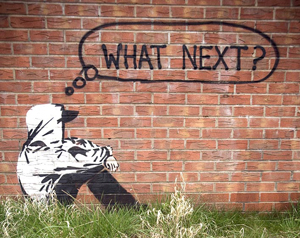 3. Engaging the ‘Disenfranchised’. Our advocates seek out and engage those groups that have a vested interest in a Viable Alternative. Perhaps the most obvious are young and disadvantaged peer groups, who have social capital but a bleak, hopeless future under the current system. We share the Prototype ‘blueprint’ with them, and encourage them to think about how they could positively transform their own environment in order to meet local needs.
3. Engaging the ‘Disenfranchised’. Our advocates seek out and engage those groups that have a vested interest in a Viable Alternative. Perhaps the most obvious are young and disadvantaged peer groups, who have social capital but a bleak, hopeless future under the current system. We share the Prototype ‘blueprint’ with them, and encourage them to think about how they could positively transform their own environment in order to meet local needs.
4. Bringing groups with an Urban Project Idea (UPI) to the Prototype. Groups with strong ideas, a willingness to learn, and a commitment to implement their UPI, are invited to the Prototype for experiential immersion in Community work, principles, values and decision-making. Stepping ‘outside’ of their everyday lives enables the groups to reflect upon their UPI with greater clarity and objectivity, and plan free of those shadowy constraints – models, relationships, habits, cues etc. – that hamper decision-making within context.
The group’s transition into participating in our emergent ‘blueprint’ is facilitated gently and mindfully. It is important we allow time for them to grasp the Prototype’s holistic model and processes, for their UPI to gestate, and for two fragile social systems (Prototype and group) to adapt to each other and reach the equilibrium necessary for them to operate effectively together.
5. Activating and sourcing capabilities in response to UPI requirements. When the group ‘feels’ sufficiently clear about their UPI, they are given the opportunity to conduct a Pilot within the Prototype.
The Community participates in related decision-making with openness and humility, seeing each UPI as an opportunity to learn and expand our own capacities. Mindful efforts are made to ensure that development is always under the direction of the group, and that our role remains that of a receptive enabler: sourcing and contributing specialism, materials and encouragement in response to the Pilot’s prevailing needs.
6. Helping realise the UPI through ongoing on-the-ground and virtual support. Upon completion of a successful Pilot, the group returns to their city or town to implement their UPI. By this time, they are equipped with ‘blueprint’ and experiences of a working Viable Alternative, and the skills to bring forth their own unique interpretation by transforming their local urban environment.
Throughout the realisation of their UPI, we continue to provide moral, specialist and financial support, and a sanctuary for retreat, review and restoration in the face of setbacks and systemic resistance.
UPIs are never colonies or subsidiaries, but rather lateral extensions of an expanding, highly interdependent Learning System. This emergent ‘Viable Alternative in action’ is held together by mechanisms that reinforce interrelationships: ritual gatherings where intent, principles and values are collectively reviewed, work and insights shared, and fun had. In the interim there are ‘dovetails’ – members whose role it is to participate in the decision-making processes of two constituent groups, thus facilitating the continuous flow of social learning through the whole system .
Although language may have represented this Action Plan as a linear sequence of stages, it was conceived as something more dynamic, reflective and feedback-driven, better captured visually in the Conceptual Model below.
And so ends our look at a possible ecology for a Prototype Viable Alternative, and an Action Plan for how it might seed nationwide transition bottom>up, inside>out and city>rural by way of an emergent Learning System.
To conclude this installment, possibly the most notable characteristic of the Action Plan on face value (particularly, one designed by a group of stakeholders operating at the leading-edge of sustainable development) is its humility. Perhaps when the scale, complexity and uncertainty of the challenge we face is spread across a wall for all to see, the only reasonable response is to design a system that acknowledges its own ignorance, creates the future one step at a time, and builds collective experience, reflection, experimentation and endeavour into its core DNA?
We hope you’ll join in a fortnight for Part 2, when we shall be exploring the four major themes that pervaded and informed the discussion of the Action Plan.
Why Corporate Regulation is a Socioenvironmental Necessity. Part 5 of 5: How do We Create a Diverse and Stable Economic System?
Welcome to the belated final installment of our five part analysis. We have been working towards the title’s conclusion by seeking an answer to the following question.
What difference between natural / social, and economic, systems causes one to tend towards diversity and stability, and the other, uniformity and instability?
In installments 1, 2 and 3, we proposed that in natural / social systems a species or ‘group’ seeking total domination of their environment are constrained and, ultimately, destroyed by the impoverishing and destabilising effects of their actions on the systems upon which their own survival depends, thus leaving the arena open for dynamics that promote diversity and long-term stability (see previous installments if you need an explanation of the model below).
In installment 4 we suggested that the current economic system displays a reverse trend towards uniformity and instability because it allows the small ‘groups’ at the helms of corporations to gain increasing wealth and power from disintegrating social / natural systems without ever personally experiencing the environmental backlash of their actions. (see installment 4 if you need an explanation of the model below).
 To clarify, this shouldn’t be taken as a demonisation of businessmen. Some individuals are naturally entrepreneurial, status-driven or materially-oriented, and the prosperity and order we have come to enjoy in recent centuries are largely indebted to their spirit and energy. Indeed, there are few among us that wouldn’t pass up a lottery win and the prestige, security and freedom it affords.
To clarify, this shouldn’t be taken as a demonisation of businessmen. Some individuals are naturally entrepreneurial, status-driven or materially-oriented, and the prosperity and order we have come to enjoy in recent centuries are largely indebted to their spirit and energy. Indeed, there are few among us that wouldn’t pass up a lottery win and the prestige, security and freedom it affords.
However, in the current era, unconstrained profit-and-power motivated vicious cycles represent a mortal threat to our freedom of choice, quality of life and, most urgently, our planet’s life systems. If the virtuous feedback mechanisms that promote diversity and stability in natural / social systems do not function naturally in the current economic system, then they they must be imposed artificially with due haste. But how?
First let’s summarise, in a nutshell, the problem to be resolved…
In the current economic system, dominant ‘groups’ are able to benefit from abusing the diversity and stability of socioenvironmental systems without ever experiencing negative feedback from their actions.
Although many possible interventions occurred to Arkadian whilst writing this series, a coherent regulatory model, which offered an unobjectionable, easy transition from the current economic system was not so easy to imagine (the reason why the final installment has been so long in coming!). Happily, a fully-formed (40yr old) solution presented itself recently in Chapter 19 of ‘Small is Beautiful’, courtesy of the genius of economist, E.F. Schumacher (pictured left).
The Schumacher Business Model, stated simply, rests on 2 systemic ‘tweaks’: (1) limiting the number of people a single corporate entity can employ and (2) introducing meaningful public ownership and accountability into business structure and practice.
(1) Legally restricting corporation size by number of employees. It would seem reasonable that a ceiling should be dictated chiefly by evidence regarding effective human group size (see Dunbar’s number), say between 80-200 persons. Growth beyond the upper limit, Schumacher suggests, should entail the formation of new independent corporate units, which may be linked by joint stock. These restrictions would enable each employee to ’embrace the idea of the business as a whole’ and the value of their role therein, but most importantly to the current argument, it would ensure that ‘the group (i.e. The Board)’ couldn’t claim ignorance of the details of their company activities and, thus, could reasonably be held personally accountable for abuses.
Furthermore, constraining size, particularly when the exploitation of natural / social resources is involved, is also more likely to physically ground a corporation in a local environment. Bringing ‘the group’ closer to their employees and the raw coal face of their realworld transactions is likely to increase their susceptibility and responsiveness to negative socioenvironmental feedback both internal and external to their organisation. It is also liable to curb the scale of impacts of which a single corporate vehicle is capable.
All very well, the cynics may cry, but what of the ‘groups’ with the thicker skins and thinner moral fibre?
(2) Public Ownership and Accountability. Schumacher advises we put an end to annual corporate taxation (a proposition not disagreeable to most businessmen!). In its place he proposes that for every share sold privately by a company, a further share is issued to the public. Thus, as owner of 50% of the company, we’d collectively receive half of any dividends if and when they are paid out to shareholders (he argues that when a company grows beyond a certain size it loses its ‘private and personal character’ and thus can be considered, in a sense, a public enterprise anyway).
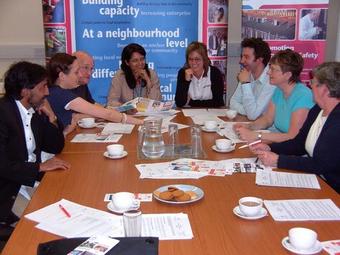 To avoid disruption, our public equity wouldn’t allow us any voting rights in everyday business decision-making. It would, however, entitle us to attend Board meetings as an observer and, if the actions of the business were deemed to run counter to the public or environmental interest, we could apply to a court to get dormant voting rights activated.
To avoid disruption, our public equity wouldn’t allow us any voting rights in everyday business decision-making. It would, however, entitle us to attend Board meetings as an observer and, if the actions of the business were deemed to run counter to the public or environmental interest, we could apply to a court to get dormant voting rights activated.
To exercise these corporate responsibilities, Schumacher proposes the creation of independent citizen bodies funded from local business dividends. These ‘Social Councils’ would be split into four equal parts: three would have their members nominated by local trade unions, professional, and environmental, organisations, with the final quarter being drawn randomly from local residents in the manner of jury service. Involvement in management processes would, of course, be bound by strict confidentiality agreements.
Schumacher’s model brings socioenvironmental feedback directly into the Board room both as a ‘possibility in the background’ and, when necessary, as a real, prevailing constraint.
It is Arkadian’s prediction that, over time, exposing the ‘groups’ at the corporate helm to these balancing dynamics would drive a new trend towards macroeconomic diversity and stability, and greater corporate responsibility for the integrity of the natural environment (by triggering the ‘Diversity Engine’, described in installments 1, 2 and 3). And to top it all, it would require minimal design and economic / legal restructuring because, in the main, the model utilises existing frameworks and practices.
To conclude, effective corporate regulation is not just a Utopian nice-t0-have. It took till 1960 for World Population to hit 3bn. It has grown by 1bn approximately every 12yrs since, probably hitting the 7bn mark earlier this year. There are more human beings to house and feed today than have ever lived before. Presently, we have just over 2 acres of workable land each, 4x less than a century ago, and this is shrinking each moment as corporate activities and climate change destroy the natural world, and population continues to skyrocket.
 Resultant biodiversity loss, whilst often second-ranked in current ‘problem’ trends is, as we’ve established, probably the most dangerous of all due to its inscrutable relationship with macroenvironmental instability. With extinctions currently at 1000x the background base rate, and predicted to rise to 10,000x over this century, we are very rapidly, and very blindly, removing the Jenga pieces of our life systems, largely for the sake of the short-term wealth creation of the small ‘groups’ of the corporate elite. History is littered with exemplars of total societal and environmental meltdown as the result of human impact on vulnerable ecosystems: Easter Island, The Mayans, The Pueblo Culture of the South Western USA, the Norse Greenland and Iceland colonies to name but a few. If we repeat the same mistakes globally, we may not get a second chance.
Resultant biodiversity loss, whilst often second-ranked in current ‘problem’ trends is, as we’ve established, probably the most dangerous of all due to its inscrutable relationship with macroenvironmental instability. With extinctions currently at 1000x the background base rate, and predicted to rise to 10,000x over this century, we are very rapidly, and very blindly, removing the Jenga pieces of our life systems, largely for the sake of the short-term wealth creation of the small ‘groups’ of the corporate elite. History is littered with exemplars of total societal and environmental meltdown as the result of human impact on vulnerable ecosystems: Easter Island, The Mayans, The Pueblo Culture of the South Western USA, the Norse Greenland and Iceland colonies to name but a few. If we repeat the same mistakes globally, we may not get a second chance.
Considering the twin pincers of population growth and biodiversity loss, it is quite evident that socioenvironmental stability and sustainability are our most important objectives for the c21st, bar none. Our very survival depends on achieving them and success is contingent upon economic and environmental policy which is underpinned by the principle of diversity=stability=good. If variety is both the spice and source of life, then we must put democratic pressure upon Government and business to make the small tweaks to our economic system necessary for it to produce abundance by its own workings.
For a fascinating and vitally important lesson in the importance of preserving and promoting biodiversity, Arkadian cannot recommend the video below more highly. Essential viewing for all inhabitants of Planet Earth.
Why Corporate Regulation is a Socioenvironmental Necessity. Part 4 of 5: Why does the current Economic System tend towards Uniformity and Instability?
Welcome to the fourth and penultimate episode of a five-part Arkadian analysis which works towards the conclusion in the series title by seeking the answer to a simple question: –
“What difference between natural / social systems and the current economic system causes the former to tend towards diversity and stability, and the latter, uniformity and instability?”
In Weeks 1 and 2, we explored why ecosystems and ‘civilisations’ tend towards diversity and proposed virtuous dynamics (the ‘Diversity Engine’) that power increasingly fine-grained specialisation / cooperation, whilst inhibiting environmental dominance by particular species or social ‘groups’. Last Week, we looked at three examples at different ‘levels’ (social group, societal, global) which illustrated why overall systemic stability and resilience, and, thus, the common good, depends on a shared responsibility for productivity produced by this trend.
Today, we aim to get the crux of the issue at the heart of this series by investigating why the current global economic system behaves in the opposite way.
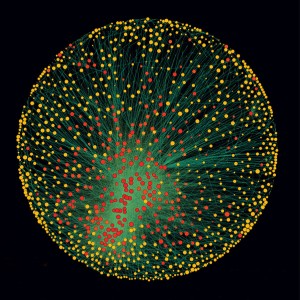 The last few decades have seen a dramatic global trend towards economic uniformity across most market sectors – most notably and worryingly, finance, media, food and agriculture, and manufacturing. A recent systems analysis by PLos One revealed that a network of 1318 companies directly represent a quarter of global operating revenues and, indirectly, via shareholdings in blue chips and manufacturing, a further 60%. Of these, a super-group of 147 companies, mostly financial institutions controls 40% of the total wealth in the system.
The last few decades have seen a dramatic global trend towards economic uniformity across most market sectors – most notably and worryingly, finance, media, food and agriculture, and manufacturing. A recent systems analysis by PLos One revealed that a network of 1318 companies directly represent a quarter of global operating revenues and, indirectly, via shareholdings in blue chips and manufacturing, a further 60%. Of these, a super-group of 147 companies, mostly financial institutions controls 40% of the total wealth in the system.
This homogeneity has also correlated with a spectacular increase in the scale and financial muscle of global corporations. A 2002 UNCTAD analysis, which used the sum of salaries and benefits, depreciation and amortization, and pre-tax income to compare firms with the GDP of countries, found that a third of the world’s 100 largest economic entities were transnational corporations. The biggest, Exxon, rivaled the economies of Chile or Pakistan; Philip Morris was on a par with Tunisia, Slovakia and Guatemala; and a more recent study research shows General Motors, DaimlerChrysler, Shell, and Sony to outsize Denmark, Poland, Venezuela, and Pakistan, respectively.
Many other corrosive trends have gone hand-in-hand with this expansion. According to statistics gathered by the New Economics Foundation, income inequality is now higher than at any other time in human history with the CEOs of the 365 biggest US companies earning over 500x that of the average employee. Corporate strategies to augment profits – outsourcing, temporary employment contracts, mechanisation and process efficiency – have eroded wages, job satisfaction and security, and human labour productivity, with the world’s biggest 200 transnationals now accounting for a third of world economic activity but employing less than 0.25% of the global workforce.
So what are the dynamics underpinning this pernicious trend? MODEL 3 of our analysis below proposes an answer (N.B. If you have trouble reading the text, click on the diagram to open it in a new browser tab and then refer back to the explanation here).
Whilst Model 3 involves more-or-less identical variables to the Models 1 (Ecosystems) and 2 (Civilisations) we explored in Weeks 1 and 2 respectively, there are several critical differences. Firstly, we broaden the definition of ‘diversity’ to include both socioeconomic and natural systems. Secondly, the term ‘group’ (which referred to political elites in Model 2) now refers specifically to the small alliance of people for whom a given corporation is a vehicle of wealth-creation: board executives, major shareholders, higher management and, to a lesser degree, senior employees, i.e. the people who don’t lose their jobs or bonuses during cutbacks.
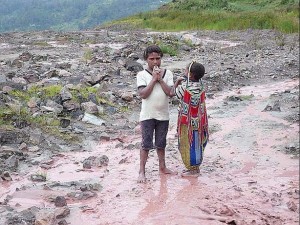 Thirdly, and most fundamentally, is a change in the polarity of the two arrows (coloured red) connecting variables (2), (3) and (4). Unlike dominant species in ecosystems and ruling elites in political systems, these ‘groups’,empowered by (7) policy and infrastructure that enable vast geographical reach, promote their self-interest and shield them against personal accountability for abuses, are able to reduce systemic diversity without their actions having corresponding negative effects on the stability and resilience of their own local environment.
Thirdly, and most fundamentally, is a change in the polarity of the two arrows (coloured red) connecting variables (2), (3) and (4). Unlike dominant species in ecosystems and ruling elites in political systems, these ‘groups’,empowered by (7) policy and infrastructure that enable vast geographical reach, promote their self-interest and shield them against personal accountability for abuses, are able to reduce systemic diversity without their actions having corresponding negative effects on the stability and resilience of their own local environment.
Indeed, (3) the greater the ‘group’s’ impact on diversity, the more prosperous and secure their personal environment becomes. Thus, in the current economic system, (1, 4, 5 and 6) the drive for dominance of rules and resources is invigorated by growing wealth, social mobility and political influence, unlike ecosystems and civilisations, where it was curtailed by its weakening and destabilising impact on the environment And so it turns: not a Balancing Loop, but a Vicious Circle: a feedback loop where one trouble leads to effects that aggravate the first trouble, and so on.
To exacerbate problems, the absence of limiting environmental feedback also reverses the dynamics of the ‘Diversity Engine’, turning it into its ominous alter ego: a Vicious Circle we’ve named the (6) ‘Benefits-of-Big Engine’.
Here, instead of a trend towards economic diversity facilitating healthy competition and new business opportunities, and making market domination progressively more difficult, a small group of dominant players is able to harness ever greater resources, economies-of-scale and mechanisms of influence (price, lobbying, political office, advertising, media, academia) to overcome existing competition and render future challengers increasingly futile and improbable.
Disturbingly, whilst in nature / society the weaknesses and instability resulting from systemic impoverishment ultimately defeat the dominant species and ruling groups responsible, thereby facilitating a new order, in the current economic system they increasingly further the interests of the corporate ‘groups’ that have caused them.
These giants can downsize, buyout or price-out smaller floundering competition, and their huge economic significance means that, even if things get really bad, national governments are likely to intervene rather than risk the impact of bankruptcy. As touched upon in Week 2, the crisis-stricken financial sector is a perfect example, where after the panic of insolvencies, public bailouts and recession, a run of mergers and buyouts gave birth to a more monolithic, powerful and fragile banking system than ever before.
 Possibly the darkest characteristic of ‘The Benefits of Big’, however, is that the larger and more ubiquitous these corporate vehicles become, and the more competitively priced their products and services, the more difficult it becomes for us to avoid participating in their expansionary activities.
Possibly the darkest characteristic of ‘The Benefits of Big’, however, is that the larger and more ubiquitous these corporate vehicles become, and the more competitively priced their products and services, the more difficult it becomes for us to avoid participating in their expansionary activities.
Thus, as customers, suppliers and employees, we all unknowingly or unwillingly, become complicit in dynamics that increasingly impoverish and endanger the systems upon which we depend.
In short, in the current economic system there appears to be no constraint on the wealth-creation of ‘groups’ at the helms of corporations other than a total socioenvironmental meltdown.
Happily, there is much we can do to change this. We hope you’ll join us next Friday for our final installment, when we shall use what we’ve learned from the virtuous ‘Diversity Engine’ of ecosystems / civilisations to propose interventions that could reverse the vicious ‘Benefits of Big Engine’ and create a self-sustaining economic system that benefits people and planet.
Why Corporate Regulation is a Socioenvironmental Necessity. Part 3 of 5: Why does A Diverse System = A Stable System?
Delighted that you’ve joined us for the third installment of our first Arkadian analysis for 2012, where over five short articles, we will show how we reached the series title’s conclusion by way of the following question: –
“What difference between natural / social systems and the current economic system causes the former to tend towards diversity and stability, and the latter, uniformity and instability?”
In Weeks 1 and 2, we investigated why ecosystems and ‘civilisation’ tend towards diversity and stability. It was proposed this was attributable to virtuous dynamics that promote long-term systemic stability and resilience by driving increasingly fine-grained specialisation / cooperation, whilst inhibiting environmental dominance by particular species or social ‘groups’.
Next week we will be putting forward an explanation as to why the current economic system displays the reverse trend but, for now, we thought it worthwhile to explain briefly the connection between diversity and stability. Why exactly does a change in the former result in a like change in the latter?
Put simply, in a diverse system, the health of the whole (‘productivity’) isn’t dependent on the performance of only a few parts.
 For example, imagine a disadvantaged family where Dad is the only breadwinner. If he has an accident, no-one eats. If the house blows down in a storm, there’s no-one to rebuild it. Compare the situation with a second family where several other members also contribute to the household income. Because ‘productivity’ is distributed across several people, the overall family ‘system’ is much more able to adapt to an accident-prone Dad and / or a force majeure.
For example, imagine a disadvantaged family where Dad is the only breadwinner. If he has an accident, no-one eats. If the house blows down in a storm, there’s no-one to rebuild it. Compare the situation with a second family where several other members also contribute to the household income. Because ‘productivity’ is distributed across several people, the overall family ‘system’ is much more able to adapt to an accident-prone Dad and / or a force majeure.
 A classic instance of systemic over-dependency at a macro-societal level is Ancient Egypt, which teetered on a single variable: the annual flooding of the Nile (taken from the excellent ‘Water’ by Steven Solomon). The ‘inundation‘, as it was known, rejuvenated the plains with fertile silt and washed away soil poisons, to produce the most self-sustaining and fertile farmlands of the ancient world.
A classic instance of systemic over-dependency at a macro-societal level is Ancient Egypt, which teetered on a single variable: the annual flooding of the Nile (taken from the excellent ‘Water’ by Steven Solomon). The ‘inundation‘, as it was known, rejuvenated the plains with fertile silt and washed away soil poisons, to produce the most self-sustaining and fertile farmlands of the ancient world.
The exclusive focus of the political elite was water management: senior priest-managers led departments for overseeing dikes, canal workers and measuring river levels; and top dog, Pharaoh’s, fundamental godly responsibility was mastery of the flow of the great river.
Unsurprisingly then, the Nile and Egyptian history ebb and flow in perfect synchronicity. Without exception, the Old, Middle, and New Kingdoms, as well as the later periods of Greek and Byzantine rule, bloom with the return of the regular cycle of flooding and crumple with climactic dry periods into centuries of disunity, chaos and foreign invasions. Thus, despite many environmental blessings, ultimately, the stability and resilience of this mighty civilisation and its elite were slave to the caprices of its one water source, in a way that a country with abundant springs, rivers and lakes could never be.
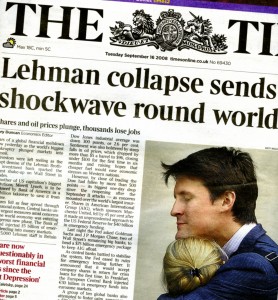 Our third and final example – the current economic downturn – illustrates uniformity and instability at a global level. Here, the world’s banking system was rendered so fragile by the interdependency of a few titanic banks and financial services firms, that massive external intervention was required to prevent total meltdown when one of them, Lehman Brothers, filed for bankruptcy in 2009. It is a crisis and an intervention for which we shall all suffer for many decades to come.
Our third and final example – the current economic downturn – illustrates uniformity and instability at a global level. Here, the world’s banking system was rendered so fragile by the interdependency of a few titanic banks and financial services firms, that massive external intervention was required to prevent total meltdown when one of them, Lehman Brothers, filed for bankruptcy in 2009. It is a crisis and an intervention for which we shall all suffer for many decades to come.
But why had the economic system not behaved like the natural / social systems we looked at in Weeks 1 and 2, and become increasingly diverse and stable as it expanded? We hope you’ll drop in next Friday to find out.
Why Corporate Regulation is a Socioenvironmental Necessity. Part 2 of 5: Why does (did) Civilisation tend towards Diversity and Stability?
Hello again and thanks for joining us for the second in a five-part Arkadian analysis, where we show how we reached the conclusion of the title series by way of one simple question: –
“What difference between natural / social systems and the current economic system causes the former to tend towards diversity and stability, and the latter, uniformity and instability?”
Last week, we explored why natural systems tend towards diversity and stability. Dynamics were proposed (the ‘diversity engine’) that, through natural selection, weed out species that strive for environmental supremacy and favour those that cooperate, specialise and, by doing so, facilitate opportunities for new evolutionary adaptations.
This week we shall take a brief look at one creature that, at first sight, appears to operate outside these dynamics: Homo Sapiens. What is it about the human species that enables it to dominate ecosystems without appearing to suffer the constraining feedback?
MODEL 2 of our analysis below proposes an answer (N.B. If you have trouble reading the text, click on the diagram to open it in a new browser tab and then refer back to the explanation here).
If you joined us last week, you’ll see immediately that MODEL 2 is more-or-less identical to MODEL 1. We propose that civilisation’s social matrix shares the same stabilising dynamics of natural systems and that these confer the ability to adapt more reflectively and effectively to environmental constraints.
Significantly, world population only began to increase appreciably with the order provided by the first civilisations from around 1,000 BC onwards. Many historians argue that the political infrastructure of Ancient Mesopotamia, Egypt, India and China initially emerged from local organisational efforts to coordinate large scale (particularly, irrigation) ecosystem management, rather than these projects being the initiative of an already-ensconced ruling ‘group’.
It is the Arkadian view that the managerial perspective born from these projects enabled infrastructural and organisational tweaks that, in turn, facilitated a trend towards increasing division of labour and role / skill / knowledge specialisation, and it was this burgeoning socioeconomic diversity and interdependence rather than the direct actions of a ruling group that provided the stability required for civilisation to flourish.
Indeed, as many power / status / wealth hungry ruling groups have since discovered to their own detriment, enduring political success hinges not on their own genius, but on the assiduous maintenance of this diversity engine. As a general rule (and as with the overbearing species we looked at last week), (1 and 2) the greater the impact of the ‘group’s’ rule and resource dominance on local socioeconomic (and environmental) diversity, (3 and 4) the more unproductive, unstable and weaker their regime tends to become.
A tragic example of this self-defeating governmental dynamic is Cambodia under the communist Khmer Rouge. Seizing power in 1975 in the wake of 4yrs of destabilising bombings by US and Vietnamese forces, they immediately shut down all transport and information links with the outside world, declared private property illegal, and established a ‘Year Zero’ for Cambodian society.
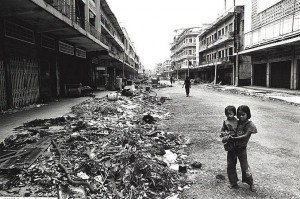 Their ‘Agrarian Revolution’ – an economic model founded on the single pillar of self-sufficient rice production – was to have a cataclysmic impact on all aspects of systemic diversity: social, cultural, economic and environmental.
Their ‘Agrarian Revolution’ – an economic model founded on the single pillar of self-sufficient rice production – was to have a cataclysmic impact on all aspects of systemic diversity: social, cultural, economic and environmental.
All those who threatened their ideological dominance were murdered or exiled – ethnic and religious minorities, journalists, doctors, educators, writers, anyone with an education – obliterating vital cultural, intellectual and skill resources.
Urban populations were forced to leave cities, towns and former roles behind to slash-and-burn virgin rain forest, set up collective farms, and take responsibility for rice production, whilst the thousands of male peasant farmers with the requisite know-how were press-ganged into military service.
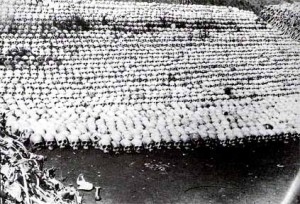 Naive farming communities went hungry rather than risk retribution for failing to meet the Government’s exorbitant rice targets, which soon resulted in a precipitous deterioration in output. Almost a quarter of the population died of starvation or execution under the regime, a disproportionate number of which were male.
Naive farming communities went hungry rather than risk retribution for failing to meet the Government’s exorbitant rice targets, which soon resulted in a precipitous deterioration in output. Almost a quarter of the population died of starvation or execution under the regime, a disproportionate number of which were male.
Within three-and-half years, the loss of diversity and productivity had rendered the Khmer Rouge’s power base so weak, they were easily overthrown by a Vietnamese invasion.
30 years later, the Cambodian ‘system’ is still suffering. Political instability has resulted in 4 coups over the interim period. The country still has the highest proportion of women (65%), malnutrition and physical disability in South-East Asia (the latter attributable primarily to the Khmer Rouge’s estimated 4-6m unexploded mines).
The country’s economy remains dependent on tenant farmers involved in backbreaking rice production for minimum profit. Necessarily, many of these are women, creating further societal tensions by violating customary rules and roles of a traditionally patriarchal society. International development experts argue that, despite the potential for a full recovery, without external intervention the Cambodian socioeconomic system will struggle to escape the impoverished, fragile state in which it was left by the Khmer Rouge.
 Conversely, ‘laissez faire’ ruling groups, such as The Ancient Greeks and Romans, that implemented policy and infrastructure which nurtured the (5/6) ‘socioeconomic diversity engine’ tended to produce history’s more enduring and resilient regimes. For example, in the mid c14th a nascent Western European civilisation – arguably, the most pluralistic, productive and market-driven the world had yet seen – successfully weathered a perfect storm of catastrophe that would have devastated a weaker social system, including climactic cold spells, famines, widespread peasant revolts, The Black Death, and an overall loss of quarter of the population.
Conversely, ‘laissez faire’ ruling groups, such as The Ancient Greeks and Romans, that implemented policy and infrastructure which nurtured the (5/6) ‘socioeconomic diversity engine’ tended to produce history’s more enduring and resilient regimes. For example, in the mid c14th a nascent Western European civilisation – arguably, the most pluralistic, productive and market-driven the world had yet seen – successfully weathered a perfect storm of catastrophe that would have devastated a weaker social system, including climactic cold spells, famines, widespread peasant revolts, The Black Death, and an overall loss of quarter of the population.
Nevertheless, (6b) although these ‘laissez faire’ strategies yielded prosperity for ruling groups, they also entailed a diminishing of their control over rules and resources as increasingly pluralistic and influential populations demanded ever greater democratic freedoms, rights and representation.
As we shall discuss in Week 4, this shift would ultimately give rise to a global economic elite whose power, and impact on diversity and stability, would dwarf that of any political ‘ruling group’. However, before we do, we thought it worth taking a moment to understand why it is that an ecosystem or ‘civilisation’ is more stable if it is diverse? Hope you’ll join us next Friday to find out.
Why Corporate Regulation is a Socioenvironmental Necessity. Part 1 of 5: Why do Ecosystems tend towards Diversity and Stability?
 Happy New Year and welcome to our first Arkadian analysis of 2012. Over the next five weeks we will be working towards the conclusion of the title of the series by exploring the answer to a simple question: –
Happy New Year and welcome to our first Arkadian analysis of 2012. Over the next five weeks we will be working towards the conclusion of the title of the series by exploring the answer to a simple question: –
“What difference between natural / social systems and the current economic system causes the former to tend towards diversity and stability, and the latter, uniformity and instability?”
In a world where the latter now poses a mortal threat to the former, we considered this to be a question of some significance. Could we learn from the way natural / social systems self-regulate in a way that benefits all, to design an ecologically-and-socially-just economic system?
Our analysis will be set out in five short articles, launching Friday mornings throughout January and early February: –
(1) Why do Ecosystems tend towards Diversity and Stability? Friday 6th January 2012.
(2) Why does (did) Civilisation tend towards Diversity and Stability? Friday 13th January 2012.
(3) Why do Diverse Systems = Stable Systems? Friday 20th January 2012.
(4) Why does the Current Economic System tend towards Uniformity and Instability? Friday 27th January 2012.
(5) How do we create a Diverse and Stable Economic System? Friday 28th September 2012.
So without further ado, let’s move onto our first question of the series:
Why do Ecosystems tend towards Diversity and Stability?
As a general rule the longer that ecosystems remain undisturbed by external factors, the richer they become. The oldest – the rainforests – are estimated to hold over half of all species, despite covering only 6% of the Earth’s surface. Why should 70m years of evolution against a backdrop of dynamic climate fluctuations give rise to increasing variety and not just a few dominant species?
MODEL 1 of our analysis below proposes an answer (N.B. If you have trouble reading the text, click on the diagram to open it in a new browser tab and then refer back to the explanation here).
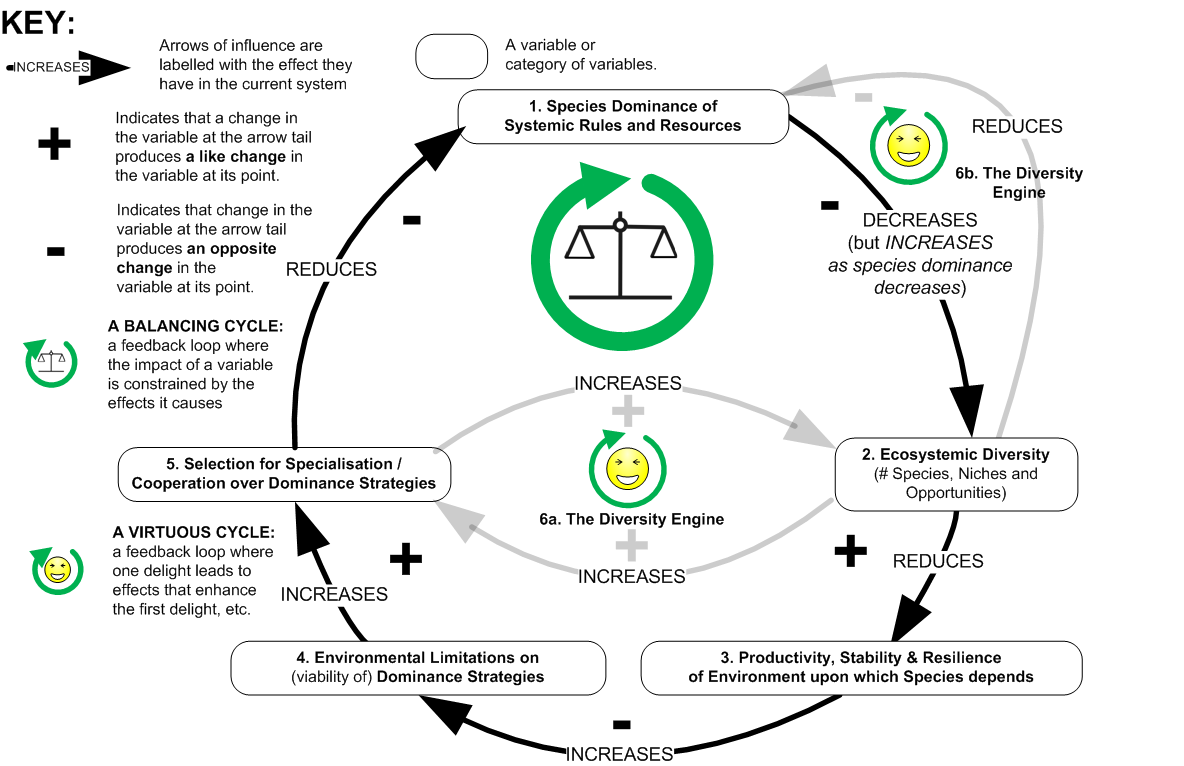 Begin at the topmost variable and follow the arrows clockwise around the loop. (1) Put yourself in the position of a species that pursues total dominance over its local environment. (2) Despite considerable early successes, it’s not long before your manipulation and consumption begin to impact adversely on other species. (3) As local biodiversity diminishes, so too do the health, resilience and stability of the ecosystem as a whole, (4) resulting in ever-tighter constraints on your actions and, ultimately, the collapse of the environment upon which your own survival depends. (5) Your extinction kills off that suicidal gene that motivated your thirst for dominance, leaving an open stage for adaptive strategies that promote ecosystemic diversity and stability.
Begin at the topmost variable and follow the arrows clockwise around the loop. (1) Put yourself in the position of a species that pursues total dominance over its local environment. (2) Despite considerable early successes, it’s not long before your manipulation and consumption begin to impact adversely on other species. (3) As local biodiversity diminishes, so too do the health, resilience and stability of the ecosystem as a whole, (4) resulting in ever-tighter constraints on your actions and, ultimately, the collapse of the environment upon which your own survival depends. (5) Your extinction kills off that suicidal gene that motivated your thirst for dominance, leaving an open stage for adaptive strategies that promote ecosystemic diversity and stability.
Thus, coming full circle, (1) Your Environmental Dominance Strategy proved self-defeating because it led to Ecosystemic Weaknesses that constrained and, ultimately, negated, You! In Systems Dynamics a feedback loop like this where the impact of a variable is reduced by the effects it causes is called a ‘Balancing Circle’.
 A further notable dynamic here is a pair of ‘Virtuous Circles’ (feedback loops where one delight leads to effects that enhance the first delight, and so on), which we’ve termed the ‘The Diversity Engine’.
A further notable dynamic here is a pair of ‘Virtuous Circles’ (feedback loops where one delight leads to effects that enhance the first delight, and so on), which we’ve termed the ‘The Diversity Engine’.
Here, (6a) the more the processes of natural selection incline towards interdependence, the more opportunities are opened up for new evolutionary adaptations. Thus, through increasingly fine-grained cooperation and specialisation between species, diversity itself drives diversity.
Moreover, as the environment grows ever more rich and complex, (6b) species dominance becomes increasingly futile and improbable, removing a further constraint on the trend towards diversity. And so both circles turn.
But (we hear you say) isn’t there a species that has had a radical effect on its local environment but has (thus far) escaped extinction? We hope you’ll drop in next Friday for Part 2, when we shall be exploring the curious exception of Homo Sapiens.
Recent Posts
- Seeding a Viable Economic Alternative. Pt 3: Placing Mother Nature First
- Seeding a Viable Economic Alternative. Pt 4: Ego-as-Process
- Charlie Hebdo and the Immorality Loop
- My Top 20 Waterfalls Pt3 (S America: #2-1)
- My Top 20 Waterfalls Pt2 (S America: #7-3)
- My Top 20 Waterfalls Pt1 (Africa, Asia, Europe & N America)
- Positive Change using Biological Principles, Pt 4: Principles in Action
- Positive Change using Biological Principles Pt 3: Freedom from the Community Principle
- Positive Change using Biological Principles Pt 2: The missing Community Principle
- Positive Change using Biological Principles, Pt 1: The Campaign Complex
- Seeding a Viable Economic Alternative. Pt 2: The Principal Themes (Outcomes of a Systems Workshop at Future Connections 2012)
- Seeding a Viable Economic Alternative. Pt 1: The Action Plan (Outcomes of a Systems Workshop at Future Connections 2012)
- What I Learned from Destroying the Universe
- Why Corporate Regulation is a Socioenvironmental Necessity. Part 5 of 5: How do We Create a Diverse and Stable Economic System?
- The Root of all Evil: how the UK Banking System is ruining everything and how easily we can fix it.
- What is Occupy? Collective insights from a ‘Whole Systems’ Session with Occupy followers
- Why Corporate Regulation is a Socioenvironmental Necessity. Part 4 of 5: Why does the current Economic System tend towards Uniformity and Instability?
- Why Corporate Regulation is a Socioenvironmental Necessity. Part 3 of 5: Why does A Diverse System = A Stable System?
- Why Corporate Regulation is a Socioenvironmental Necessity. Part 2 of 5: Why does (did) Civilisation tend towards Diversity and Stability?
- Why Corporate Regulation is a Socioenvironmental Necessity. Part 1 of 5: Why do Ecosystems tend towards Diversity and Stability?





